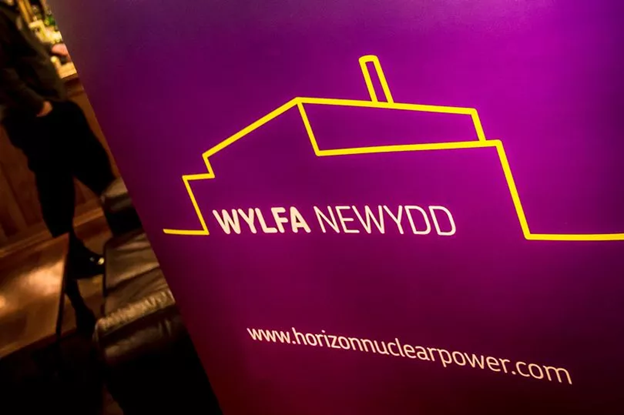Rishi Sunak is the Prime Minister of the United Kingdom (U.K.). He says that Wylfa, on Anglesey, will be named as one of the preferred sites for a new nuclear power station within months. He called it a “fantastic site” that could host both small modular reactors (SMRs) and big conventional reactors. Sunak said, “Wylfa is somewhere that could do both” He added that the preferred sites would be announced later this year.
Sunak called SMRs the “nuclear technologies of the future.” They are nuclear fission reactors that produce less than three hundred megawatts of electricity. It has been claimed that they will be cheaper and safer than old full-sized reactors.
The original Wylfa nuclear power setation stopped producing electricity in late 2015. Last year, the U.K. government launched its Energy Security Strategy. Wylfa was mentioned as one of the possible sites for new nuclear builds.
Sunak told a reporter that he was “committed to nuclear power in general because it is an important part of how we deliver energy security in the UK, but also how we decarbonize over time to get to net zero but in a proportionate and pragmatic way. Now Wylfa is a fantastic site because it can do both potentially giga-watt power but also could do small modular reactors. Without getting into too much of the specifics, later this year we will be announcing the sites for the next stage of our SMR process on small modular reactors. I can’t say much more before then but obviously Wylfa is somewhere that could do both.”
Last may a report by the Welsh Affairs Committee urged U.K. ministers to show “more concrete commitment” to a new nuclear power station at Wylfa. The report warned that Hitachi’s cancelled bid to construct one in 2020 had “scars on the local community”.
Sunak made a passionate defense of the U.K. government’s deal with Tata to keep Port Talbot steelworks open which was announced earlier this month. The Port Talbot plant is the biggest steel plant in the U.K. It is slated to receive a subsidy of six hundred twelve million dollars from taxpayers to install an electric arc furnace to produce steel in a greener way. However, as many as three thousand jobs will be lost across the U.K., mainly in Port Talbot. Unions are calling the deal a “devastating blow for workers.”
Sunak said denied the charge that the plans were not ambitious enough. He said, “I think it is a very glass half empty way to look at it. That steel plant was facing compete closure – 8,000 jobs would have been lost, that’s what people were worried about. What’s happened here is that the government has stepped in, that’s the UK government not the Welsh government, the UK government has stepped-in and provided an enormous amount of support to help that steel plant have a sustainable long-term future, producing clean steel and saving 5,000 jobs. That actually, compared to what the situation was, shows that the UK government is committed to the people of Wales, committed to steel-making and can look forward to a much more sustainable future for the plant and that area.”
Blog
-

Nuclear Reactors 1278 – U.K. Will Choose A Site For New Nuclear Builds In The Near Future
-
Links for 12 Sept 2023
South Korea’s Yoon Warns Against Russia-North Korea Military Cooperation voanews.com
The risk that nuclear weapons could be used is tremendous news.yahoo.com
Iran demands US show goodwill after quitting nuclear deal marketscreener.com
Polish regulator ready for nuclear program, IAEA says world-nuclear-news.org
-

Nuclear Reactors 1277 – Idaho National Laboratory Studies Heat Transfer In Nuclear Fuels
The transporting of heat is an important part of our daily life, from boiling a pot of water to creating complex carbon-free energy technologies that power our cellphones, laptops, and home appliances.
Nuclear energy is an example of heat transfer. It has a proven track record spanning over seventy years. Nuclear power provides about twenty percent of the total electric energy generation in the U.S. A nuclear reactor is similar in principle to a fossil energy plant in that thermal energy (heat) is used to generate steam. The steam is then converted to electricity using a steam turbine. As the nuclear industry moves to advanced fuel cycle technologies, efficiently transporting heat energy becomes increasingly important. Meeting this challenge requires an understanding of microscopic mechanisms that control the transport of that heat.
In typical nuclear fuel, a uranium atom absorbs a neutron, becomes unstable and splits which results in the creations of two new lighter atoms. This process imparts sufficient kinetic energy to these new atoms to displace thousands of adjacent atoms from their equilibrium positions. This causes the creation of microscopic defects in the crystalline structure. Furthermore, this process produces heat that must flow through the fuel element. Then the heat must be transferred out of the coolant. Finally, the heat must produce steam for making electricity. The crystalline defects degrade the ability to transfer heat. This is a quality known as its thermal conductivity.
David Hurley is an Idaho National Laboratory Fellow and director of the Center for Thermal Energy Transport under Irradiation (TETI) which is an INL-led Energy Frontier Research Center supported by the Department of Energy’s Office of Science. He said, “Over the lifetime of the fuel in a reactor, its thermal conductivity decreases by as much as 70%.”
The degradation of a nuclear fuel’s thermal conductivity is a challenge for efficient nuclear power operations. However, researchers are learning that this degradation can be mitigated by improving the design of the chemistry and structure of the fuel. Fully achieving these mitigation strategies will require going beyond trial-and-error investigative approaches.
This is where TETI comes into play. The mission of the center is to accurately predict and ultimately improve the transport of thermal energy in nuclear fuels in extreme radiation and temperature environments. Hurley said, “Because our materials of interest contain uranium, quantum mechanical approximations such as density function approximations all fail at some level. What sets TETI apart is its ability to tackle this problem while staying as close to the first principles of quantum mechanics as possible.”
In its first four years, TETI scientists utilized inelastic neutron scattering to gain critical new insights into resolving the atomic scale mechanisms governing thermal transport in defect free, ceramic nuclear fuels. TETI scientists also applied beyond density functional approximation in order to discover a new energy state of uranium oxide, lower than previously reported. Linu Malakkal is one of the principal investigators on the TETI team. He said, “The lowest energy state is the correct state, and we are getting very close.”
Hurley said, “As we look to the future, it is important to realize that the tools developed by TETI researchers will not only impact advanced nuclear energy concepts but will offer opportunities for other energy-related technologies beyond nuclear energy, such as thermoelectric or photoelectric energy conversion, and/or new quantum materials.” -
Links for 10 Sept 2023
Turkey and China nearing a nuclear power plant deal middleeasteye.com
IAEA Chief Verifies Iran’s Nuclear Compliance miragenews.com
Cracks at V.C. Summer nuclear plant raise concern from federal regulators wltx.com
Takahama-2 Becomes 12th Nuclear Power Plant To Return To Service Since Fukushima nucnet.org
-
Links for 11 Sept 2023
Pakistan has 170 nuclear warheads and may increase the number to 200 by 2025 livemint.com
Australian Government says coal-to-nuclear switch would cost $249bn power-technology.com
Russia’s Shoigu inspects nuclear submarine modernization in Far East reuters.com
South Korea’s Yoon Warns Against Russia-North Korea Military Cooperation voanews.com
-
Links for 09 Sept 2023
Turkey and China nearing a nuclear power plant deal middleeasteye.com
IAEA Chief Verifies Iran’s Nuclear Compliance miragenews.com
Cracks at V.C. Summer nuclear plant raise concern from federal regulators wltx.com
Takahama-2 Becomes 12th Nuclear Power Plant To Return To Service Since Fukushima nucnet.org
-

Nuclear Reactors 1276 – Australia Does Not Need Nuclear Power – Part 2 of 2 Parts
Part 2 of 2 Parts (Please read Part 1 first)
Bowen’s estimate claims that it could cost three hundred eighty-seven billion dollars to replace every Australian coal plant with nuclear SMRs. However, the Coalition has not yet proposed such a plan. O’Brien’s response was to cite the nuclear heavy Canadian province of Ontario as an example of a power grid that is much cleaner and cheaper than here.
However, the Ontario system runs on old, large-scale nuclear power technology that no one is proposing for Australia. It has a different cost profile, has been heavily subsidized and a new plant has not been completed for thirty years.
An honest comparison would involve looking at the cost of SMRs today and considering what it would cost to start an industry in Australia.
The Commonwealth Scientific & Industrial Research Organization (CSIRO), which has examined the evidence, concluded that this is near to impossible because of a lack of robust data. It says that there are only two known SMR in operation. One is in Russia on a barge, and another is in China. Both suffered serious cost overruns and delays that have become common with nuclear projects.
According to the International Atomic Energy Agency (IAEA) there are more than eighty other SMR designs in development. Only some of these could be used for generating electricity. The IAEA says that their economic competitiveness is “still to be proven in practice”.
It will probably be years before that picture becomes any clearer. Ontario hopes to have an SMR online in 2028 and three more by the mid-2030s. O’Brien has mentioned a plan by TerraPower to build a demonstration SMR in Wyoming. It has a budget of about three billion eighty and six dollars for a plant with about one fourth of the capacity of an Australian coal power generator, and construction has been delayed. TerraPower hopes to have their SMR operating by late 2029.
While concerns about nuclear waste remain real, the world needs all available technology to get out of fossil fuels. However, the idea that Australia should wait for an unproven technology to arrive which it already has extraordinary clean energy resources at its disposal defies all logic.
Meanwhile, the world is in the grip of the hottest year in recorded history. The fire season has already begun in mid-September. The sea ice around Antarctica is at a record low. Credible bodies such as the Australian Academy of Technological Sciences and Engineering now argue that Australia should be aiming to be net zero by 2035. By this date, if things go really well, there will only be a small handful of SMRs in operation.
The transition away from fossil fuels is definitely challenging. There are huge policy and social license issues that need to be dealt with so that the rollout of renewable energy can accelerate. Carbon emissions from transport, major industry and agriculture are not coming down.
Solutions are certainly available. Imagine what might be possible if all the political energy dedicated to the nuclear energy future went into developing those alternatives. -
Links for 08 Sept 2023
Rwanda signs agreement to build test nuclear power reactor reuters.com
North Korea could get satellite and nuclear weapons help from Putin. Why it matters. Usatoday.com
Cyber Risks to Nuclear Weapons: Proposals from a U.S.-Russia Dialogue nti.org
Teacher removed over ‘inappropriate’ nuclear fallout shelter assignment nbc11news.com
-

Nuclear Reactors 1275 – Australia Does Not Need Nuclear Power – Part 1 of 2 Parts
Part 1 of 2 Parts
The Coalition and News Corp has been engaging in a vague, ideological push for nuclear power in Australia. Critics believe that this push is the latest step in a decades-long campaign of delay and denial on the climate crisis.
Nuclear energy probably has a role to play in the global shift to zero-carbon emissions in places where it is already used or that have few other options. As is the case with many other technologies, its role may grow or recede over time as time passes.
However, no good case has been made to support the claims that nuclear power has a place in the rapid transition underway in Australia. The reason for this is fairly obvious. The small modular reactor (SMR) technology that is being promoted does not really exist.
This suggests that the current wave of nuclear promotion is really just an anti-renewable energy campaign. It is based on an arrogant and unsubstantiated rejection of the detailed evidence from the Australian Energy Market Operator and others that solar, wind, hydro, batteries and other support can provide a reliable, affordable, low-emissions electricity supply,
Coincidentally or intentionally, many prominent members of the pro-nuclear and anti-renewable energy campaign dismiss climate science. Some critics do this directly. Some critics do it indirectly by arguing that there is no urgency to act.
The primary sources of this climate change rejection are the federal Coalition, the Australian newspaper and the misinformation channel of Sky News After Dark. The Australian often runs unquestioning news stories claiming multibillion-dollar “black holes” in renewable energy plans which are based on flawed analysis by former mining executives. But then it devotes pages to criticizing an estimate by Chris Bowen’s energy department that says that nuclear energy would be really expensive.
The Australian is a newspaper that gives more space to contrarian campaigns by individual scientists who claim that the Great Barrier Reef is not under threat and the Bureau of Meteorology’s temperature records cannot be trusted than it does to the overwhelming consensus of thousands of peer-reviewed science papers.
The Coalition’s position on nuclear power is a little more slippery. To be fair, the last election was only sixteen months ago, and it is reasonable that it has not yet developed an energy policy. However, the language that it employs is not that of a party gently exploring an idea. Peter Dutton has asserted that Australia could build nuclear power plants, which are banned, on the site of existing coal-fired power plants.
The Coalition considered and rejected abolishing the nuclear power ban while it was in power for almost nine years. Then, the party stuck to its status quo on climate. This included promoting a subsidized “gas fired recovery” that never took place. Now, Dutton and Ted O’Brien, the energy and climate spokesperson, talk about nuclear power as the obvious solution and mock those who back the rollout of renewable energy and new transmission lines.
O’Brien said that the cost of introducing nuclear power in Australia “depends on the way that you model it”, which may be true but does not mean much.
Please read Part 2 next -
Links for 07 Sept 2023
Shuttered Michigan nuclear plant moves closer to reopening under power purchase agreement newpressnow.com
UN Nuclear Watchdog Meeting Ends Without Censuring Iran iranintl.com
UN Nuclear Watchdog Risks Running Out of Money on US, China Standoff news.yahoo.com
UK, Germany, France and US says Iran must clarify issues over nuclear material reuters.com
